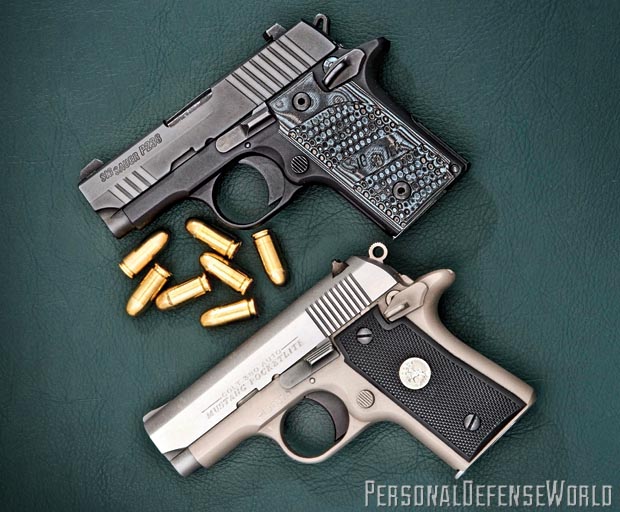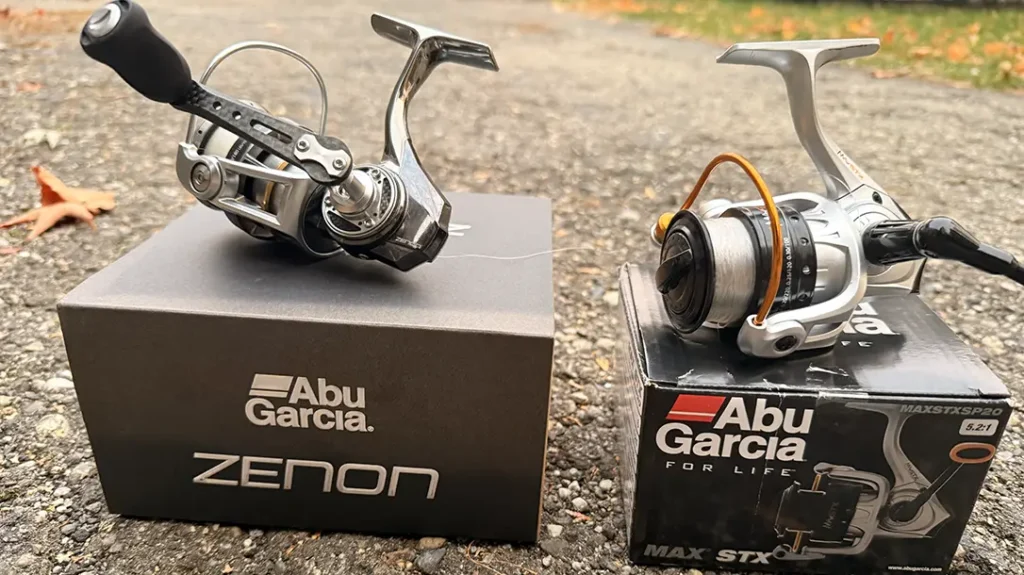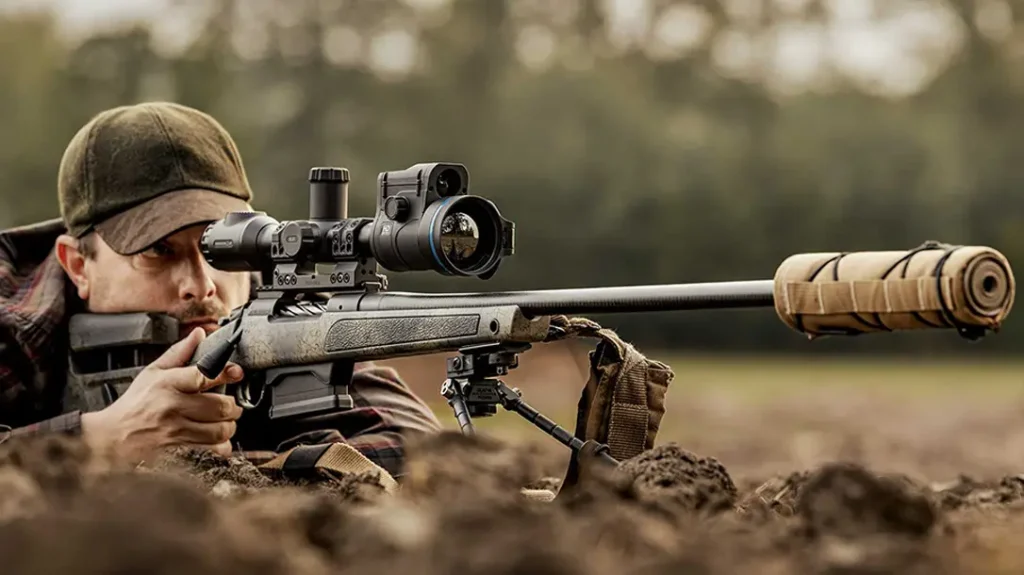Irony; the dictionary defines it as “…an outcome of events contrary to what was, or might have been expected.” Here’s one for you. In 1908 John M. Browning invented the .380 ACP cartridge and the first semi-automatic Colt pistol designed to fire it.[1] Aptly named the Colt Model 1908, this was also the first medium caliber semi-auto handgun (the .380 being essentially a 9mm short) designed for concealed carry. It had been preceded in 1903 by another Browning and Colt collaboration, the Model 1903 chambered in .32 ACP. The Model 1908 was manufactured until 1940 but remained popular long after production ended as a General Officer’s issued sidearm during WWII.
Forty-three years after the original Colt .380 pocket model had been discontinued the company brought back a .380 Auto Government Model Series 80, and in 1991 a Government Pocketlite version. However, in 1986 Colt’s had introduced a second .380 model, this one a subcompact named the Mustang. Small, lightweight and dispensing six rounds of .380 ACP through a 2.75-inch barrel; variations of the Mustang pocket pistol were manufactured until it fell from grace with consumers near the end of the 20th century.
Then in 2003 something contrary to what was, or “might have been expected” happened; Kel-Tec introduced the subcompact P-3AT .380 Auto.
Advertisement — Continue Reading Below
The public loved it, and with an increasing number of individuals obtaining CCW permits, the compact, easy to carry .380 ACP became a popular handgun again (overlooking, of course, the continuing fame of the Walther PPK and PPK/S). Armsmakers the world over quickly began introducing innovative new subcompact .380s; Ruger, Kahr, Taurus, Magnum Research, Smith & Wesson, Sig Sauer and others, all doing what Colt’s had first done almost 20 years earlier, leaving the historic Hartford, Connecticut, armsmaker as one of the few major arms manufacturers without a .380 model in their product line. And that constitutes an irony.
Gun Details
With the Colt’s Manufacturing Company celebrating its 175th anniversary in 2011 it seemed an excellent opportunity for the legendary American armsmaker to bring back one of its more fabled handguns, one, that as previously noted, like so many Colt models of the past, was ahead of its time. The re-introduction of the .380 Mustang Pocketlite couldn’t have been better timed. Undoubtedly the company had a lot of motivation to re-develop and re-introduce the .380 Mustang Pocketlite, none so great perhaps, as the Sig Sauer P238. Introduced in 2009, the P238, for all intents and purposes, is a nicely executed Sig Sauer version of the Mustang. And it has become so popular in the last three years that Sig now offers more than a dozen variations and finishes. So, it only seems fitting that the originator should step back into the spotlight.
Advertisement — Continue Reading Below
Notes Joyce Rubino, Colt’s Vice President of Marketing, “The precise machining process, use of high quality materials and improvements in design make the new .380 Mustang Pocketlite one of the most consistent and reliable firearms on the market. The aluminum alloy receiver, stainless steel slide and barrel are CNC machined from solid bar stock for precise tolerances. Machining solid stock is certainly a more involved manufacturing process, but it is that process, combined with our engineering specifications, expertise and demand for perfection that allows Colt to deliver one of the highest quality products available to today’s marketplace.” Indeed, the Mustang needs no “introduction” as it is an established name, but the use of new construction methods and materials make the revised .380 ACP noteworthy.
With a loaded magazine the Mustang tips the scales at less than a pound. It measures 5.5 inches long (thanks to an extended beavertail) with a 2.75-inch barrel. The beavertail is a definite advantage on a short-recoil operated system where the slide travels well back over the web of the shooting hand. The minimal weight and length of the gun—combined with the short single-action trigger, proven frame and grip design, and firing pin safety block—make this an ideal small caliber handgun for personal protection and concealed carry. The magazine holds six rounds, so capacity is seven with one in the chamber, and cocked and locked is the standard carry method, just like a Model 1911. Additionally, the Mustang Pocketlite does not use a magazine disconnect, so it will discharge a chambered round with the magazine removed.
.380’s Legacy
Advertisement — Continue Reading Below
Although often regarded as a sub-standard round for self-defense, the .380 ACP has managed to prevail as a staple in self-defense sidearms for more than 100 years. And recent improvements in bullet designs and ballistics have increased both the velocity and terminal performance of .380 caliber ammunition, making the cartridge a viable option for today’s self-defense and concealed carry use.
Having tested several Colt Mustang models over the years this latest iteration looks and feels different with an overall superior fit and finish, particularly the slide to frame fit. But what is most noticeable is the contrast between the stainless steel slide and the matte, bead blasted appearance of the aluminum alloy electroless nickel frame. The side panels of the slide and its nine rear serrations are all bright stainless, as is the hammer, while the thumb safety, slide and magazine releases are a brushed stainless finish to complement the top of the slide. It is a handsome and durable combination that offers both style and serviceability for concealed carry. If there is one improvement that Colt’s should have added it would be a better front sight, rather than the same low, integral ramp type as used on earlier models. While this is the Pocketlite’s single greatness weakness, it is also true to the original design of the autopistol.
While some regard the Mustang as a scaled down Model 1911, it is only partially so, because the .380 uses a solid camming lug barrel system in place of a traditional 1911-style swivel-link, and a direct barrel/frame interface rather than a barrel bushing. The Pocketlite also has one other distinctive difference; a thumb safety that allows the slide to be manually cycled even when the safety is set. This permits checking for a loaded chamber, clearing the gun or loading the first round with the safety engaged. If the hammer is down on a loaded (or empty) chamber and the thumb safety is set, the gun will not cock but the hammer will move back into a half cock notch and stop. Releasing the thumb safety will allow the hammer to be fully cocked. The Colt design uses a firing pin safety block to prevent accidental discharge.
Advertisement — Continue Reading Below
Given the gun’s size and ease of handling I opted to go straight for pocket carry with the Colt Mustang. The best fit was a Galco Pocket Protector PRO438 in natural rough out leather. This rig grips pocket fabric like a magnate and stays put when the gun is drawn. It has a wide, double thickness stitched opening that stays rigid for easy re-holstering and also provides the necessary stiffness to keep the holster from collapsing in the pocket. The Mustang’s rear sight rests firmly on top of the pouch with the grips cleanly exposed and the thumb safety clear of gun leather. The hooked lower edge of the Pocket Protector also helps ensure that the gun and holster remain upright in the pocket. This proved to be an excellent choice for carrying the Colt .380 ACP.
Range Time
The Pocketlite has a very solid feel in the hand, more so than .380’s with a polymer frame. While this adds a little overall weight, the heft makes the Mustang substantial in terms of grip and recoil management. The large 1911-style thumb safety is very easy to release on the draw and has a positive lock that you can feel and hear when pushed upward into the locked position, or when thumbed down to release.
Advertisement — Continue Reading Below
The latter, however, is a bit of a “tell” to anyone within earshot. While there is ample triggerguard room to move the index finger in and out without brushing against the trigger, this would not be the case if wearing a glove, and greater care is necessary. When gripping the gun the little finger wraps easily under the magazine floorplate for support.
Trigger pull on the test gun averaged 4.7 pounds with 0.19 inches of take-up, no stacking, very slight overtravel and quick reset, all characteristics of a well-engineered trigger system. For ease of function, getting the Pocketlite into action is almost seamless from the time you wrap your fingers around the grips. The large, round knurled hammer spur is easy to thumb back, the slide release is firm but drops with modest pressure on the reload, and recoil spring tension for chambering a round or clearing the gun is comparatively light.
The face of the slide is also of sufficient surface area to make cycling the action against a flat edged surface, or even the heel of one’s shoe, easy enough in a situation where one-handed operation might be critical. These are all pluses for a defensive sidearm.
Advertisement — Continue Reading Below
Disassembly for cleaning is basic, requiring a cleared action and cocked hammer (magazine removed), then simply pushing the slide back to the disassembly notch and removing the slide stop. The slide then pulls forward off the frame. Reassembly is just as quick. This is another area where the use of a camming lug barrel system and direct barrel/frame interface pay off, versus the more complicated 1911 disassembly protocol.
With a consistent trigger pull, short take up and quick reset, rounds fired at 1-second intervals struck consistently just above point of aim from 21 feet (7 yards) on a Speedwell B-27 silhouette target. Recoil from all three types of ammo fired was modest allowing quick follow-up shots. The greatest issue found with the Mustang is reacquiring the front sight after recoil, which against a dark background, like a B-27 silhouette, isn’t that difficult as the light colored sight is in stark contrast, but against a lighter background it would not be nearly as easy to do. The best accuracy came with Hornady Critical Defense 90-grain FTX, which cleared the Colt’s barrel at 930 feet per second (fps), placing five rounds at 1.0 inches in the 10 ring at 5 o’clock (three overlapping), followed by a nearly identical group at 3 o’clock in the 9 ring at 1.2 inches with Federal Premium 90-grain Hydra-Shok traveling down range at 908 fps. The widest group, but all in the X, was Sellier & Bellot 92-grain FMJ, which cleared the traps at 845 fps placing five rounds at 2.0 inches in the X.
Overall this is a very easy gun to handle and shoot. And that is what you expect from a Colt. The Mustang Pocketlite delivers….again. For more information, call 800-962-2658 or visit coltsmfg.com.
























